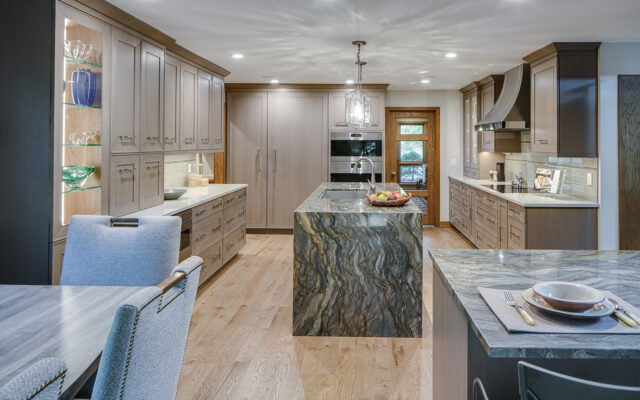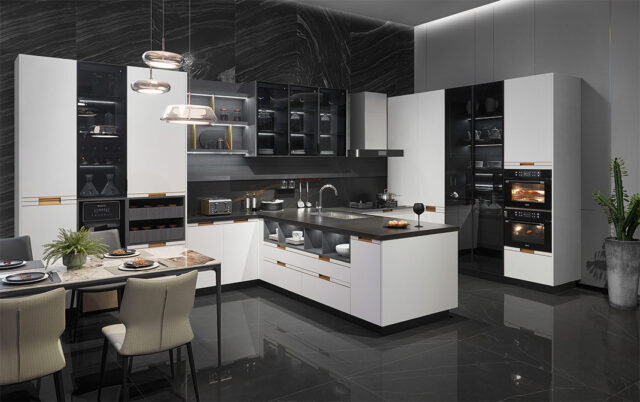
Open-concept kitchens, which blend cooking spaces seamlessly with adjoining living zones, have become exponentially popular over recent years. Eliminating divides between the kitchen and rooms like the living room, dining room, etc. lends homes a more unified, spacious aesthetic. This integrated layout also supports better traffic flow and flexibility of usage across the whole space. And by thoughtfully incorporating suitable countertops into open-concept designs, we can optimize both visual appeal and functionality even further.
Defining the Open-Concept Kitchen
An open-concept kitchen removes walls and barriers between the cooking area and surrounding rooms to “open up” everything visually and physically. This merged layout eliminates confining separation to instead support continuous traffic patterns and flexibility of activities. Open kitchens feel more inviting, inclusive spaces for family and friends to interact during meal preparation, dining, homework, hobbies, and hosting gatherings. With fewer structural divisions, smart countertop specifications become even more important as anchors that polish off the design.
Countertops Set the Tone

In open interconnected rooms, counters read as visual anchors that tie the separate zones together. Since the kitchen flows openly to other rooms, the materials, colors and finishes of counters should feel cohesive across all spaces so décor reads as a unified whole. Kitchen countertops also see heavier use in integrated layouts. From meal prep to impromptu seating and hobby stations, open kitchen surfaces need high durability and easy maintenance to support multifunctionality. The experts at Bedrock Quartz tell us that quartz composites, porcelain tiles, and sustainable wood materials perform well on all fronts.
Strategic Counter Shaping and Placement
Thoughtful shaping and placement of countertops also proves vital in open designs to connect spaces ergonomically. Counters should feel unified to promote seamless workflow and movement between areas, rather than disjointed fragments marooned in space. Expansive kitchen islands, extended bar top counter space, and ample perimeter run room help kitchens operate smoothly while accommodating flexible activities.
Clever changes in counter heights also helps zone open kitchens for varied functions. A section of raised counter invites casual dine-in eating or standing prep work. Lowered counter portions cater better to kids’ tasks or intricate cooking jobs completed while seated. Countertop “desk areas” flanking the stove provide space for appliances, oils and gadgets so multiple cooks can spread out across the ample surface area.
Countertops Impact Aesthetics
Beyond functionality, counters also influence aesthetics in open kitchens. As anchor pieces grounding the space, attention-grabbing countertop materials make a huge visual impact. Bold patterns, intriguing textures, eye-catching colors, or multi-layered finishes all lend character and reinforce style statements. Concrete counters with embedded glass fragments catch the light beautifully to complement all-white palettes. River-rock quartz islands anchor farmhouse schemes with organic depth while vivid turquoise porcelain tile bar tops inject pops of color. Choosing counter materials as deliberately as cabinetry finishes helps realize the desired aesthetic.
Embrace Visual Continuity

Since open kitchens blend into surrounding rooms, décor elements should feel continuous rather than disjointed. Countertops play a major role in establishing this visual continuity across the open layout. Keeping counter materials, colors and finishes cohesive as they extend across zones creates crucial flow. A quartz-topped kitchen island and dining room buffet table feel harmonious in the same soothing gray wood-look finish. Contrasting countertops used in the same open space can feel disjointed.
Conclusion
In open-concept kitchen layouts, counters play more sizable roles from both aesthetic and functional standpoints. In essence, counters ground the design physically and visually in dynamic open kitchens. Their strategic specifications give unified open spaces added polish and purpose. And with fewer structural divides, countertops here contribute visual continuity, high functionality, and character critical to letting these multifaceted spaces thrive.



